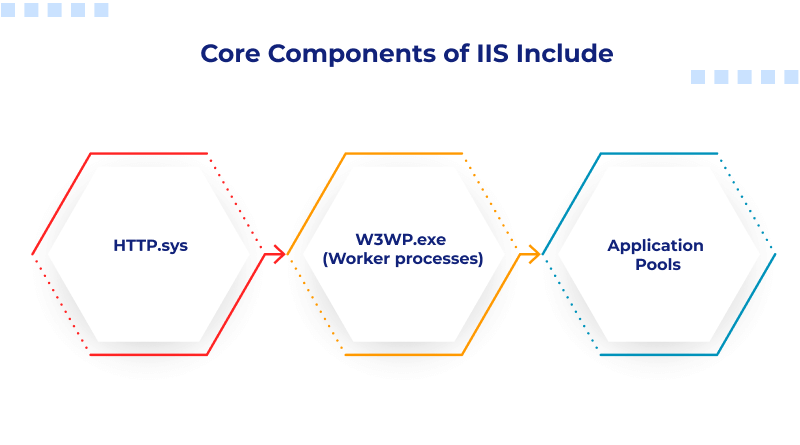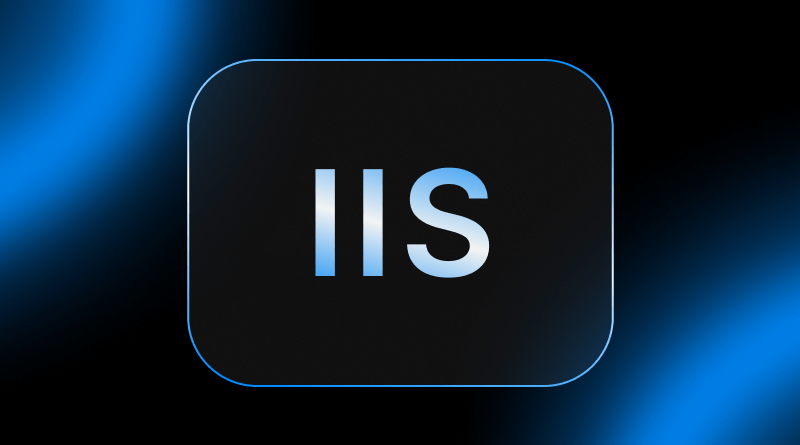According to the latest reports by BuiltWith, approximately 7.3 million live websites currently use IIS. The Web has become intertwined with daily living as well as corporate activities. From corporate dashboards to web-based applications and websites, there is always an unseen background system that helps power such tools, such as IIS or Internet Information Services, by Microsoft.
IIS (Internet Information Services) is the web server application provided by Microsoft. Integrated robust security features and high configurability offer a lot on the positive side. As it is tailored for Windows server operating systems only, the websites and applications require heavy processing on a single server, leading to simplified manageability.
IIS servers reliably deliver .NET apps, REST APIs, and other digital content with built-in load balancing. The internal IT structure also benefits from effective web hosting services offered by IIS that allows effortless management of staging environments and company tools along with the primary webpage.
In this post, we will cover an overview of what a web server IIS is, how it works, and its features and functionalities, including its modular design. We will further explain why it is one of the cornerstones in both public and private web ecosystems.
Table Of Content
The Core: What is a Web Server and Where Does IIS Fit In?
To understand Internet Information Services (IIS), it helps to begin with the basics: what is a web server?
A web server is a type of computer software or even hardware that accepts requests made by browsers from different networks and sends back the information to the original source.
This may include some scripts and files such as images, pages, and websites written in HTML.
For a better understanding of the type of web server we are using today, we should know that every one of us actively uses IIS. Microsoft designed an application called Internet Information Server as their main product. From there all enterprise IT systems grew where they required high security levels that could support even simple websites and more complex applications deployed on the intellect server (Microsoft Windows OS).
Overview of Web Server and IIS main features:
- Request Handling: IIS waits for users to connect (usually over HTTP/HTTPS) and processes their requests.
- Processing: It collects static materials such as HTML documents, pictures, and other files or runs server-side programs like ASP.NET or PHP.
- Response Delivery: The browser should receive responses from the server, thus completing the process.
This model helps companies to reliably host web applications and services while exercising strong control over performance and security.
How Does IIS Work? A Close Look
To fully understand the role of the IIS server, it is important to know what happens under the hood. Essentially, an IIS system works on a request-response approach. This provides seamless content delivery to users seamlessly.
Look at this sequence for the lifecycle of an IIS request:
- Client Request: The web browser’s address bar has a URL (www.companysite.com), so now we assume there’s a request created on the Web Server side waiting for fulfillment.
- Worker Process (W3WP.exe): Each application pool spins up a worker process dedicated to handling the request. This process either fetches static files or performs dynamic application logic.
- Processing: For static files such as HTML, CSS, JavaScript, and images, the IIS retrieves these files and delivers them automatically. Dynamic content such as ASP.NET or PHP is processed through their respective engines for responses.
- Client Response: The data received after processing flows back from the user browser through Worker Process, IIS, and HTTP.sys to reach backend systems.
Core Components of IIS Include:

- HTTP.sys: It is also called Window’s Kernel and it’s the component of Operating System Processing. A TCP connection is established and basic filtering is performed before requests are passed to Internet Information Services.
- W3WP.exe (Worker processes): These are run under user mode (Thread) responsible for hosting apps/ application processing and relevant codes (executable paths / binaries).
- Application Pools: These represent separated portions within system components known as virtual directories. They allow different web apps to run independently—boosting security, reliability, and performance.
This architecture is what makes IIS such a powerful tool in web hosting and IT infrastructure, capable of scaling with enterprise needs while maintaining high availability and isolation.
| Component | What It Is | Role in Request Lifecycle | Why It’s Important |
| HTTP.sys | Kernel-mode HTTP listener. | First to receive all HTTP requests; acts as a gatekeeper. | Efficiently handles network traffic, passes to IIS. |
| W3WP.exe (Worker Process) | User-mode process executing app code. | Hosts specific applications; retrieves files or runs dynamic logic. | Executes our applications; keeps them running. |
| Application Pool | Logical container for worker processes. | Isolates web apps from each other; directs requests to W3WP.exe. | Enhances stability and security for our diverse apps; prevents crashes from spreading. |
Benefits and Features of IIS
An IIS server has a lot more functions than simply hosting web pages. It provides reliable security, high performance, and easy management for hosting applications over Windows Servers. This is achievable through the characteristic rich set of features provided by IIS along with its robust architecture.
Windows Server implements a rich set of features that are offered through Internet Information Services (IIS), which is also characterized as a powerful, flexible system architecture.
IIS Modular Architecture: Is IIS a Modular Web Server?
With modular web servers such as IIs the structure is broken down into different sections based on use case requirements where feature-specific components called modules can be enabled or disabled, giving it modular functionality that improves extensibility with the aid of performance and security.
Advantages of Modular Architecture
- Add-on Flexibility: Tailor-made to adjust to individual business needs while adding only critical requirements for improved efficiency.
- Safety: Limit additional risk exposure by deactivating unsafe parameters around fortress deployment scenarios.
- System Efficiency: Shift between dynamic and static operations, providing a leaner approach without overhead processes.
- Customizability: Servicing behavior response towards setting adjustments demanded by application presence.
Examples of Common IIS Modules:
- ASP.Net: Hosting active dynamic framework WebApps.
- PHP module: Containing retrieval abandonment through fast CGI- powered product websites.
- URL Rewrite Module: To manage user-friendly URLs and redirects.
- Request Filtering: To block malicious or unnecessary requests.
Core IIS Features:
– Security
- Authentication: Enables anonymous, basic, and Windows frameworks.
- Authorization: Access rights can be controlled at a granular level.
- SSL/TLS: Security protocols for the encryption of traffic.
- Restrictions by IP Address and Domain: Determines access boundaries based on client information.
– Performance
- Caching: Storing frequently accessed data speeds content delivery.
- Compression et al.: Use GZIP or Deflate to reduce payload size.
- Output Caching: Improvement of dynamic page response time.
- Application Pool Recycling: Provides stability for long-term applications.
– Management
- IIS Manager GUI: Offers user-friendly graphical interfaces.
- PowerShell Cmdlets: Server configuration automation.
- AppCmd.exe: Manages CLI functions associated with scripting
– Extensibility
- Support for ASP.NET, PHP, Node.js, and Python integrated through modules and extensions.
– Reliability
- Application Pool Isolation: Ensures protection against an application crash by isolating web apps
- Rapid Fail Protection: Prevents cascading failures from occurring
– Logging & Diagnostics
- Failure Request Tracing: Finding unsolved issues and performance leak areas.
- Detailed Logs: Tracks every audit request and troubleshooting request.
Other Integrated Systems Extension of IIS:
- URL Rewriting: Create clean, SEO-friendly URLs.
- Request Filtering: Protect from unwanted harmful predefined patterns while restricting accepted request types.
- FTP Publishing: Publish housing accounts and manage transferred files based on FTP protocols.
- WebSockets Support: Activating real-time full-duplex communication for apps like chat or live dashboards.
All these capabilities make IIS a comprehensive solution for enterprise-grade web hosting and IT infrastructure needs.
Why IIS Matters?
In any company, IIS (Internet Information Services) has an important part in maintaining the IT infrastructure. It supports the corporate intranet, employee portals, and other internal applications, testing, staging tools, and servers. For all core applications, such as business-critical reporting tools or HR portals, hosting and delivery are done through seamlessly integrated IIS on Windows Server.
For IT teams, there are several advantages gained from ITO services tailored through internet exchanges. With its integration into Windows environments, administrative tasks become fused with back-office Windows user-friendliness. This further enhances HR and Business Operations Portals that use their purposeful Microsoft-tailored processes.
Built-in security features, such as authentication protocols or SSL/TLS granted automatic inclusion that safeguards data confidentiality and grants us peace of mind for internal relics while pending external virtual threats.
Internet Information Services (IIS) is a web server developed by Microsoft, which serves websites, applications, and services in the Windows Server ecosystem. It forms an integral part of our IT infrastructure because of its ease of management and powerful features such as application pooling, security controls, and modularity. It also simplifies web hosting.
IIS knowledge is essential for maintaining and scaling our tools as well as for sustaining team productivity. We encourage self-exploration through the development servers, internal documentation, or even reaching out to the infrastructure team for more assistance.
FAQs
1. Does IIS only run on Windows operating systems?
Microsoft develops products solely operated on Windows, including Windows Server editions (used for production) and desktop versions like Windows 10/11 (used for testing). Therefore, it has no running capabilities on Linux or macOS natively.
2. What is an “Application Pool” in IIS and describe its significance?
In IIS, an Application Pool is one or several web applications that share a dedicated worker process (W3WP.exe) to run. It is important because it offers process isolation—when one app crashes or hangs, other apps are not impacted.
3. Is IIS a modular web server? What does that mean?
Absolutely. IIS is a modular web server, which means its core functionalities are structured as separate modules. These can be added or removed based on the application’s requirements. This results in better performance (only loading necessary components), increased security (reduced attack surface), and customization (customized server configurations).
4. Do I need to enable specific features within IIS after installation?
Yes. The basic setup received from installing the IIS role via the Windows Server Manager interface or PowerShell requires additional configuration, enabling role services like ASP.NET, PHP support, URL Rewrite, FTP Publishing, and several authentication options manually depending on requirements. This kind of modularity ensures efficiency for the applications being served.















